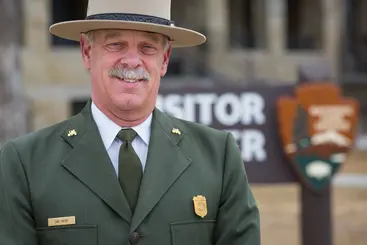WALL, S.D. – As the sun begins to warm the expansive plains of South Dakota, a seasonal transformation takes place. Wall Drug, an iconic fixture and a beacon for travelers from across the world, gears up for its busiest months. Drawing over 2 million visitors annually, Wall Drug occupies nearly an entire block of this quaint town with a population of approximately 800 residents. Known for its legendary free ice water, 5 cent coffee, and fresh donuts, Wall Drug has become a must-stop destination for those exploring the American Midwest.
 Dan Wenk, who oversees Mount Rushmore, discusses the challenges faced by South Dakota’s major attractions.
Dan Wenk, who oversees Mount Rushmore, discusses the challenges faced by South Dakota’s major attractions.
As South Dakota embraces the peak tourist season, the indispensable attractions such as Wall Drug, Badlands National Park, and Mount Rushmore National Memorial face a common hurdle—securing a seasonal workforce. A recent panel discussion featured on SDPB’s “South Dakota Focus” brought Sarah Hustead, Mike Pflaum, and Dan Wenk together to shed light on seasonal employment at these attractions, foundational to South Dakota’s tourism industry.
Sarah Hustead, the fourth-generation leader of Wall Drug, explained the rigorous steps taken to prepare for the influx of summer tourists. “We employ about 70 year-round workers,” she noted, “but we need roughly 120 more seasonal employees each summer.” The hiring process begins in October, focusing on programs like the H-2B and J-1 visas, bringing workers from diverse nations such as Thailand, Kazakhstan, Mongolia, and Jamaica. This labor diversity enriches the small town of Wall, turning it into a multicultural hub during the peak months.
The melting pot that Wall Drug becomes each summer is not without its challenges. Housing, an often-overlooked aspect of seasonal employment, becomes a critical issue. Unlike larger cities, Wall’s rental market can’t easily accommodate the influx. In response, Hustead explained, “We own a trailer court and several houses to ensure our workers have a place to stay.” This foresight not only supports employee well-being but also boosts recruitment efforts.
Beyond Wall Drug, South Dakota’s natural wonders like the Badlands National Park experience similar challenges. Mike Pflaum, former superintendent and now a special adviser for the nonprofit Badlands National Park Conservancy, highlighted, “Seasonal employees are often the face of the park. They handle everything from fee collection to visitor program operations.” The federal hiring freeze and subsequent layoffs in 2025 added layers of uncertainty to an already complex hiring landscape. Despite these challenges, Pflaum remains optimistic, stating, “We will have a seasonal workforce, though we can’t predict how these changes will affect the visitor experience.”
Mount Rushmore, another South Dakota treasure, is no stranger to these workforce dynamics. Dan Wenk, former superintendent, laments the loss of seasoned seasonal employees due to recent uncertainties, stressing their importance in maintaining the park’s educational and operational standards. His insights resonate with a broader audience of national park enthusiasts and underscore the necessity for stable hiring practices.
As the conversation encompasses the broader community of tourist attractions, housing once again emerges as a mutual concern. Pflaum noted, “Housing is a perennial issue in many national parks.” The scarcity leaves seasonal workers searching for accommodation in nearby towns like Interior, Kadoka, and Wall. Despite their best efforts, the challenge persists, influencing worker satisfaction and retention.
For the locals and tourists alike, the interconnectedness of these issues—the shared reliance on seasonal workers, the struggle for adequate housing, and the resilience of community-driven attractions like Wall Drug—paints a larger picture of South Dakota’s tourism landscape. The collaboration between federally-managed parks and private businesses not only enhances visitor experiences but also fosters a sense of community among residents and visitors.
Catch the season finale of “South Dakota Focus” for a deeper dive into how these factors shape South Dakota’s tourism industry. Tune in on Thursday, May 29, at 8 p.m. Central Time on SDPB-TV1, YouTube, or SD.net. For more details on South Dakota’s unique attractions and their pivotal roles in tourism, contact info@sdnewswatch.org.
Through these shared stories, Wall Drug and its South Dakota counterparts highlight the resilience and ingenuity required to thrive in the face of challenges. While challenges remain, the efforts of community leaders and workers alike showcase a commitment to making South Dakota destinations vibrant and welcoming for all.